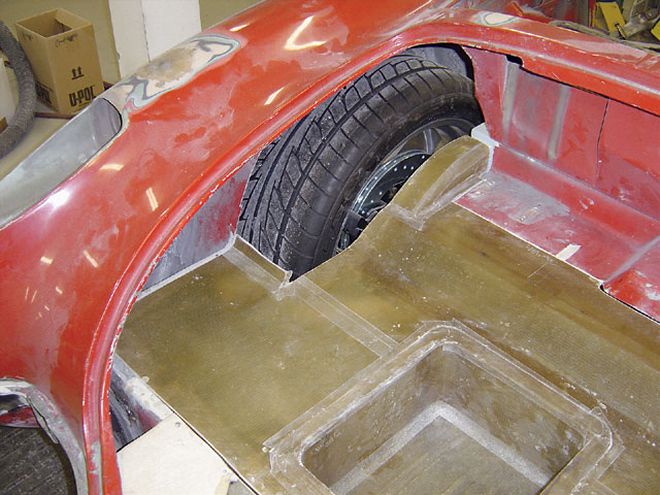
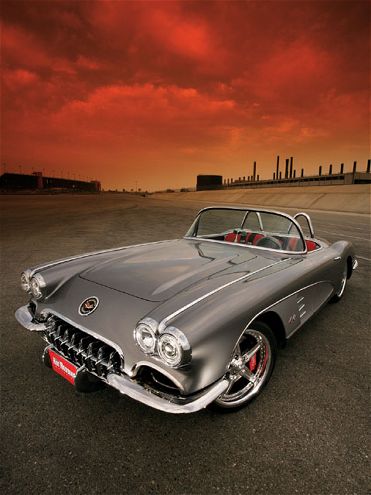
A few years ago, it was big news when Art and Craig Morrison constructed a complete frame and suspension for '55-'57 Chevys that set new handling and lateral-g test numbers for those classic shoe boxes. In fact, that project, the GT55, was even quicker and more athletic than any car we had tested at the time, including the then-new ZO6 Corvette. From that, a new idea evolved to produce a fresh chassis for first-generation (C1) Corvettes that would blow away anything coming out of Detroit. When Art and Craig first came to PHR with the idea for doing a take-no-prisoners C1 chassis, we went all-in with the car's complete buildup. Over the next few issues, we will detail the design and build out of the 3G Vette, and wrap up the series with a full feature and complete track test. We made sure to have the testing in the bag before printing our first story, so trust us when we say Project 3G Vette won't disappoint. But first things first. Here's the low-down on the 3G's chassis design, as told by Craig Morrison of Art Morrison Enterprises. -Johnny Hunkins
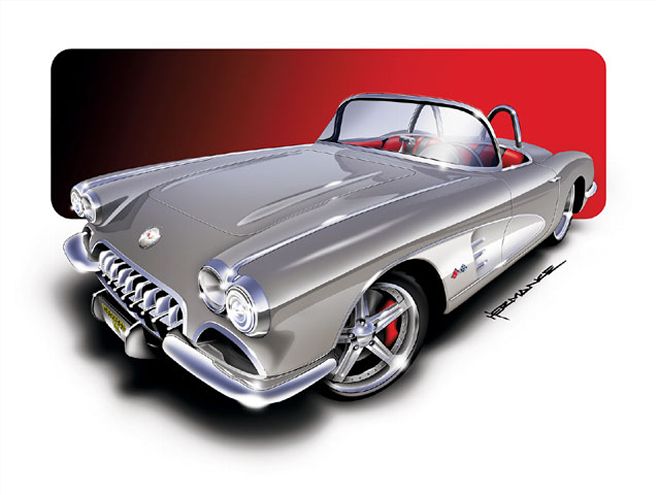
All benchmarks are there to be broken. And so it goes with our previous levels of performance. Coming off the unbelievable high of achieving 0.94g on the skidpad with our '55 Chevy GT55 project, we wanted to do better-we were looking to hit the magic 1g with our latest 1960 Corvette project. Not only that, we wanted to hit all 3 of the g's with our next project. That is, 1g minimum on the skidpad, 1g minimum of acceleration, and 1g minimum of braking. We have set the bar high, and initially we thought maybe too high. To achieve such goals, the car needs to be well balanced; the suspension, weight, power, tires, and brakes all need to be working together for us to achieve our desired level of performance. This project definitely isn't about the biggest engine, the most power, or the largest tires we can cram into America's first sports car. It's about balance, and overall vehicle performance.
 To make room for the meaty 295mm Michelin Pilot Sport Cup tires, the rear wheelwells on our '60 Corvette were modified accordingly.
To make room for the meaty 295mm Michelin Pilot Sport Cup tires, the rear wheelwells on our '60 Corvette were modified accordingly.
With our sights set high, the natural starting point was the chassis, and we'd work our way up from there. The foundation of this project was our latest frame, a high-performance replacement for the '53-'62 (C1) Corvette. Starting with a complete set of original GM blueprints, the challenge was to fit the desired suspension within the confines of the original chassis shape, and under the fiberglass floorpans. Because we had obtained rock-solid data directly from GM on chassis dimensions, body-mount measurements, core support location, and bumper mount locations, this part of the chassis construction was fairly straightforward. Even the OE engine location worked to our advantage because it was dramatically set back from the front spindle, giving us the potential for great weight distribution. Because we wanted to make this a bolt-on chassis, we weren't out of the woods yet. We still needed to design the suspension, lower the car's ride height, lower the Cg, and make allowances for larger tires.
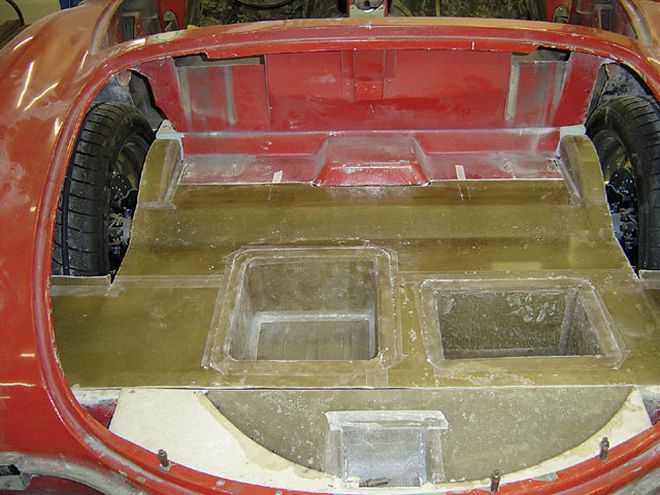 Because we weren't going to run a spare, the trunk floor was also modified to make room for a battery box and a hidden toolbox.
Because we weren't going to run a spare, the trunk floor was also modified to make room for a battery box and a hidden toolbox.
Because of the limits of what we could do packaging-wise, this next phase was a real challenge. Incorporated into the chassis design were exhaust ports, which run the exhaust through the chassis rather than under it, enabling everything to be tucked above the lower edge of the chassis. In doing this, we instantly gained an extra 3 to 4 inches of ground clearance. This lets us have a ride height of 4 to 4.5 inches, and still gives us plenty of clearance for normal day-to-day driving. The gussets for the through-frame exhaust even helped with the tortional rigidity of the chassis, increasing tubing stiffness by 5 percent. Aesthetically, this cleaned up the underside of the car as well. There is no longer anything hanging below the chassis, giving the car a cleaner profile, and making it possible for customers to run a bellypan if they want.
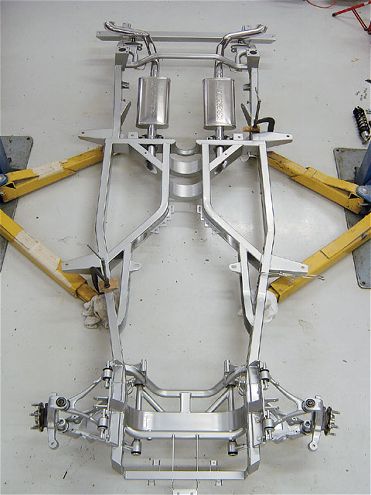 Just back from the powdercoater's, we placed the prototype GT Sport C1 chassis on the lift, and began the assembly.
Just back from the powdercoater's, we placed the prototype GT Sport C1 chassis on the lift, and began the assembly.
Next, we needed to address the issue of larger-than-stock tires, since the original Corvettes were equipped with anemic 6x70x15s. To get any reasonable-sized tire in there, the body needed to be mini-tubbed. In order to maintain balance with the tire selection, we first looked at the front of the car to help us determine what we could fit out back. After much measuring and CAD analysis of the chassis, it appeared we could fit 265s up front. Based on estimates of the overall weight and balance of the car, it was determined that 295s were about as big as we should go in the back. Any wider than this, and it would begin to introduce understeer. After the tire sizes were determined, we adjusted the rear rails accordingly, and made the necessary wheelwell modifications to get everything to work.
Relying on experience once again, we decided to go with a triangulated four-bar rear suspension. While the triangulated four-bar is a hotly debated Internet topic, our personal experience with this type of suspension has been tremendous. After 7,000-plus miles of flogging this type of suspension on our '55 Chevy project, we still haven't been able to find its limitations. There were other advantages to using this type of suspension as well. Because we don't need a track locator (as the upper tubes are angled, and square the rear end), it allows more room for the exhaust system. With our already established triangulated four-bar, the upper tubes were moved down to the centerline of the axle, thereby creating a low roll center with very little migration during hard cornering. We were also able to package this suspension under the OE floor without modifications.
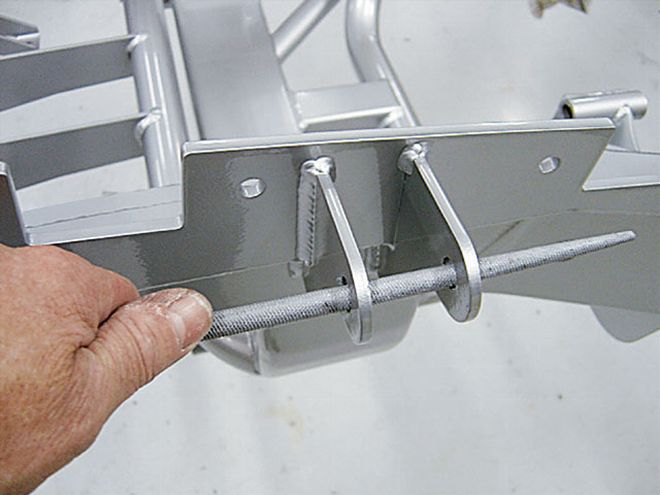 After powdercoating a chassis, it's important to chase all suspension holes with a file to remove excess buildup of material.
After powdercoating a chassis, it's important to chase all suspension holes with a file to remove excess buildup of material.
The front suspension was different from our previous GT55 project, however. Because of the massive stock engine setback, we were able to use C5 Corvette front suspension without having to alter the steering arms, or rack-and-pinion location. (Since this build, we have upgraded our chassis to C6 components. In addition, the stock C5/C6 suspension's one drawback is its relatively high steering arm, which causes interference in a lot of applications.) While the Corvette components remained unaltered, the geometry was changed to maximize performance for this particular application.
Working with our desired tire and wheel package, the track width was designed to reduce the scrub radius. However, there was enough left in the geometry to provide the driver with an optimum amount of feedback while driving. The caster was also modified to help with steering feel, and to further improve and stabilize roll-center migration. The ratio of the roll center vertical change to the ride height is kept at 1:1. This helps to provide a constant feel when transitioning from a straightaway into a turn. In order to reduce unpredictable suspension movements and jacking effects, the static roll center was lowered by 1 inch. While this slightly increases body roll, it was a necessary compromise to make. Overall, lateral roll-center migration has been reduced by 50 percent for a more stable and predictable handling car. To realize a higher camber gain for severe cornering, the front view swing arm (FVSA) was shortened. While the FVSA was shortened, the side view swing arm (SVSA) was lengthened. This was done for two reasons. First, because this car will be lower and have a higher spring rate than the C5, less anti-dive is needed to achieve adequate suspension movement while braking. Second, by lengthening the SVSA, there is also less caster change as the suspension goes through its range of travel. Bump steer and Ackerman angles were modified to provide the driver with crisp, quick turn-in when cornering, but not at the expense of making the car unpredictable at high speeds. In fact, the Ackerman was reduced slightly for less tire scrub on big, sweeping corners. The suspension was also set up for toe-in while braking (rather than toe-out on the stock C5) for better control under lockup conditions.
With thousands of hours of work put into building this high-performance replacement frame for the C1 Corvette, we were satisfied with the chassis and the suspension design, and were confident of what it could do once the gauntlet was thrown down. Next month, our focus will shift to the next "g," acceleration, and how we can build enough reliable horsepower to achieve this goal without sacrificing the other two g's.